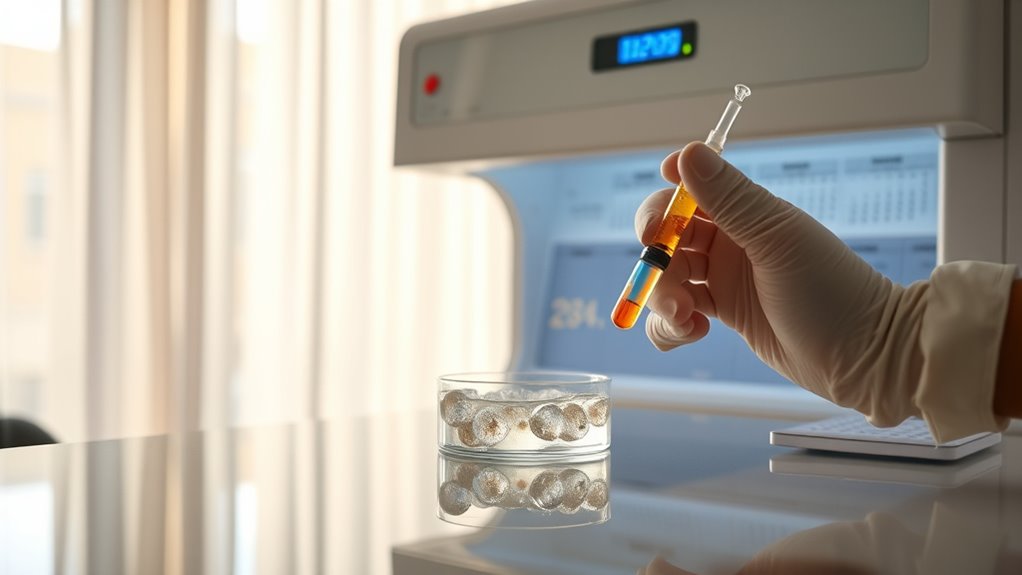If you’re exploring IVF, you’re looking at a hopeful process that assists individuals and couples with infertility. It involves stimulating egg production and retrieving eggs for fertilization outside the body. You’ll find that medications play a vital role, and thorough evaluations help tailor your journey. While understanding risks is important, emotional and financial support can help you through. Stick around to uncover more about your options, and how to navigate this journey successfully.
Key Takeaways
- IVF involves fertilizing eggs with sperm outside the body, providing options for various infertility challenges.
- The process includes ovarian stimulation, egg retrieval, fertilization, and embryo development over several days.
- Medications used in IVF include hormones to stimulate egg production and support embryo implantation.
- Pre-IVF considerations involve medical evaluations, lifestyle changes, emotional support, and financial planning.
- Risks include ovarian hyperstimulation and emotional stress, while alternatives like Natural Cycle IVF may also be explored.

In Vitro Fertilization (IVF) offers hope for individuals and couples struggling with infertility, as it allows eggs to be fertilized by sperm outside the body. If you’re facing challenges conceiving—whether due to female, male, or unexplained infertility—IVF can be a viable path to parenthood. Over the years, the process has become safer and more effective, boasting impressive success rates that can help make your dream of having a family a reality.
The IVF process begins with ovarian stimulation. You’ll take fertility drugs to encourage your ovaries to produce multiple eggs. Once your eggs are ready, a minimally invasive procedure is performed to retrieve them. On the same day, sperm is collected from your partner or a donor. Afterward, the fertilization occurs in a lab where eggs are combined with sperm. In some cases, a technique called Intracytoplasmic Sperm Injection (ICSI) is used to directly inject sperm into the eggs, increasing the chances of fertilization.
The IVF journey starts with ovarian stimulation and egg retrieval, followed by lab fertilization and advanced techniques to enhance success rates.
As fertilized eggs develop into embryos over several days, medications play a crucial role in your IVF journey. Gonadotropins stimulate egg production, while GnRH Agonists and Antagonists help regulate hormone levels to prevent premature ovulation. Once your eggs are mature, Human Chorionic Gonadotropin (hCG) triggers ovulation, and progesterone supports embryo implantation during the luteal phase. You’ll typically self-administer these medications via injection. The IVF process involves five main steps, which include stimulation, retrieval, fertilization, culture, and transfer.
Before starting IVF, a thorough medical evaluation will assess your reproductive health and hormone levels. You might also need to make lifestyle modifications, such as maintaining a balanced diet and avoiding harmful substances. Emotional support and financial planning are essential, given the emotional and financial demands of the process.
While IVF is generally safe, it does come with risks, such as Ovarian Hyperstimulation Syndrome (OHSS) and the possibility of multiple pregnancies if more than one embryo is transferred. Emotional stress and mild physical discomfort during the embryo transfer can occur too. Success factors include your age, the quality of your eggs and sperm, and the selection of healthy embryos for transfer. Choosing the right clinic can also significantly impact your experience and success rates.
If IVF isn’t the right fit for you, alternatives like Natural Cycle IVF or using donor eggs or sperm can be considered. Whatever path you choose, understanding the basics of IVF will empower you as you navigate this journey to parenthood.
Frequently Asked Questions
How Much Does IVF Typically Cost per Cycle?
IVF typically costs between $14,000 and $20,000 per cycle.
You’ll also need to budget for medication, which can add another $3,000 to $7,000.
If you opt for additional procedures like ICSI or PGS, those can increase your total significantly.
Remember, if multiple cycles are needed, your expenses could easily surpass $50,000.
Be sure to check your insurance coverage, as that can also influence your out-of-pocket costs.
What Are the Success Rates for IVF by Age?
Imagine standing at the crossroads of hope and uncertainty, where your age shapes your chances.
For women under 35, success rates soar above 50%, while those aged 35 to 37 see a dip to around 40.8%.
As you enter your late 30s, success plummets to about 26.8%, and for women over 40, it’s a challenging road, often below 10%.
Each step may require multiple cycles, but advancements can still light your path.
Can IVF Be Used for Same-Sex Couples?
Absolutely, IVF can be used for same-sex couples!
Whether you’re a female couple looking to share the pregnancy experience through reciprocal IVF or a male couple using gestational surrogacy, there are options available.
You’ll need to select egg or sperm donors and go through the IVF process, which includes embryo creation and transfer.
This journey can be emotional, so having support is vital as you build your family together.
What Are the Common Side Effects of IVF Medications?
When you start IVF medications, you might experience various side effects. Common ones include headaches, hot flashes, and nausea, particularly with oral medications like Clomid.
Injectable medications can lead to bruising at injection sites and, in rare cases, ovarian hyperstimulation syndrome (OHSS). Abdominal pain and breast tenderness are also possible.
It’s essential to communicate with your healthcare provider to manage these side effects effectively and ensure your comfort throughout the process.
How Many Embryos Are Typically Transferred During IVF?
Think of your IVF journey like planting seeds in a garden.
Typically, you’ll transfer one to three embryos, depending on factors like your age and prognosis. If you’re younger, a single embryo transfer (SET) is often recommended to minimize risks of multiple pregnancies.
Transferring more embryos can increase immediate success but also the chance of complications.
Ultimately, the goal is to nurture the best chance for a healthy, thriving pregnancy.
Conclusion
In the journey of IVF, you’re not just planting seeds of hope; you’re nurturing dreams of family. While the path may feel like a winding road, each step brings you closer to the possibility of new life. Embrace the ups and downs, and remember that every effort counts. With knowledge and support, you’re equipped to navigate this adventure—transforming your aspirations into reality. Keep faith alive, and let your heart guide you forward.









